As you can notice, the online space is now filled with podcasts. Apps like Spotify and Apple Music actively promote this type of content, and the creators themselves post a lot of short-form content on platforms like TikTok or Instagram Reels. It’s easy to rely on podcasts for information, mainly since even governments or schools use them for information-sharing.
However, podcasts can be extended. It’s time-consuming to listen to whole podcasts. Playing them at a faster speed can also lessen understanding. Thus, using podcast-to-text converters might be helpful if you want to consume podcasts quickly. This guide will walk you through reliable tools of this type.

In this article
Part 1: Top 7 Podcast to Text Converters
In this list, seven podcast-to-text tools will be available for your use. Remember, you are the final judge. Try out each tool thoroughly to make an informed decision as to what fits your needs well. As a preliminary tip, make sure to use those tools that have AI transcription services. Artificial intelligence has advanced enough to be reliable in making a transcript out of speech.
Nevertheless, keep an open mind while reviewing the top tools we prepared for you. Ready another device to access them while reading through. Meanwhile, here’s a table that compares all the choices below:
| Tool | AI-powered | Notable features |
| Filmora | Yes | Video and audio editing support Built-in sound effects and music library AI-powered audio-to-text and text-to-audio function Cross-platform availability |
| Notta | Yes | Real-time transcription 58 languages supported Speaker differentiation function Multiple export formats (TXT, PDF, Word, SRT) |
| ReStream | Yes | Free service with no account required 15 languages supported TXT format transcript output |
| Podsqueeze | Yes | High-speed transcription (30-minute podcast in under 5 minutes) Speaker identification with timestamps SRT file export for captions |
| Kapwing | Yes | Accurate audio-to-text conversion Direct synchronization with media files 70+ languages for translation and dubbing |
| Descript | Yes | 95% transcription accuracy Text-based audio editing Multiple export formats (SRT, Word, Markdown) |
| Tactiq | Yes | Live meeting transcription via Chrome extension Speaker identification Google Docs, Notion, Slack, PDF 30+ languages supported |
Wondershare Filmora
To jumpstart our list is Wondershare Filmora. You might be confused because Filmora is known as a video editing tool. Well, this is what makes it the perfect choice for transcribing. Recently, Filmora has been equipped with AI tools such as speech-to-text functions. With this, you can repurpose the content quickly within the video editing tool.

Filmora is all about creativity. As a video and audio editing tool, it offers the following features that enrich your transcribing experience:
- Speech-to-text/AI Caption. Its AI speech-to-text feature can generate captions and a detailed transcript that doesn’t miss out on key details. Just use the AI tool to create the transcript for you.
- Audio Enhancement Tools. Filmora also offers a range of audio editing tools like equalizers, noise removal, and more that can help enhance the audio quality. This will, in turn, improve the accuracy of the transcript because there is less noise in the source file.
- Audio and sound effects library. Suppose you’re also looking to make a podcast or work on other audio-related projects. In that case, you can enjoy the extensive sound effects and music library as part of your Filmora experience.
- Cross-platform. To top it all off, Filmora is a cross-platform tool that supports cloud saves. This means you can work on your desktop and pick up your work on the go through your smartphone.
How To Convert Podcasts to Text With Wondershare Filmora Mobile
As mentioned, Filmora has a mobile version. Since many users listen to podcasts on their phones, it might be a good idea to have the tool handy for making transcripts or generating captions. Thus, to use Filmora mobile as a podcast podcast-to-text converter, follow the steps provided below:
Step 1: Go to AI Captions from the homepage and Import the podcast’s video file.
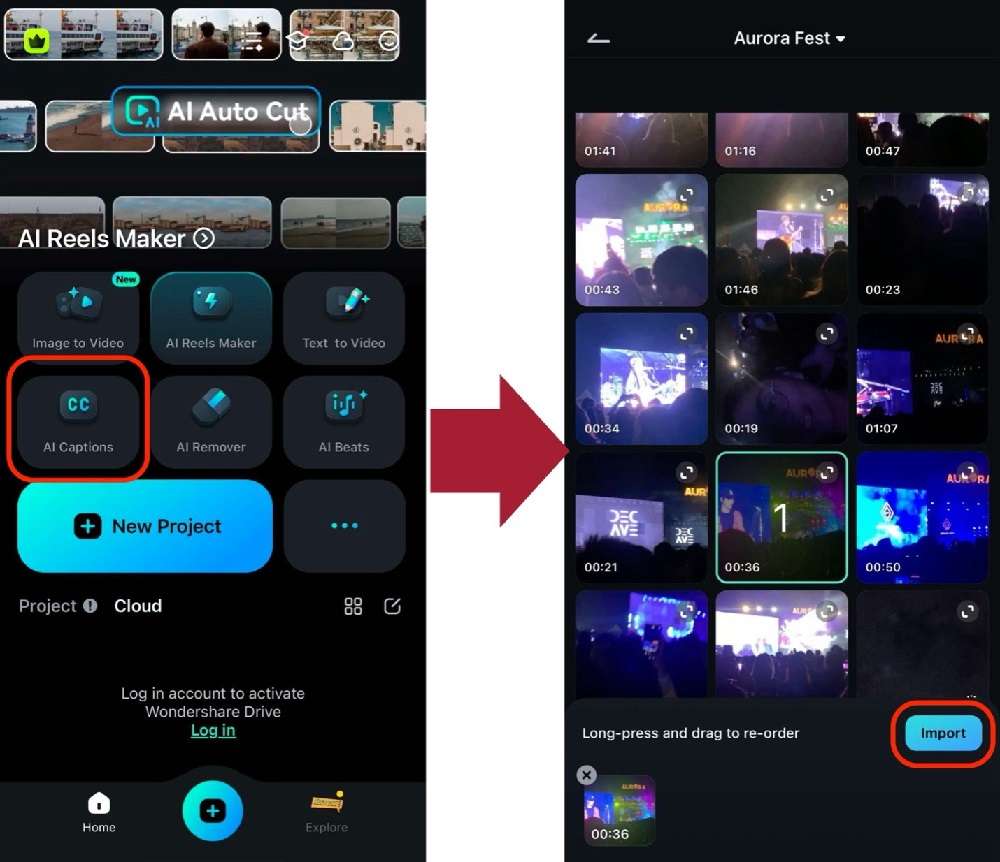
Step 2: On this page, use the following functions as needed:
- Select current language. Determines the target language for the transcription to ensure accuracy in the AI’s transcription.
- Bilingual captions. Allows a second language that the AI will also understand. This is great for podcasts where the speakers code-switch between two different languages.
- AI Packaging. It provides fantastic text effects that automatically highlight important parts. Great for social media captions.
- Speaker Detection. Allows the AI to determine who the current speaker is and label it accordingly in the captions.

It’s that easy to generate audio-to-text transcriptions with Wondershare Filmora mobile. Keep it handy around you to create captions and transcripts anywhere and anytime.
Notta
Notta transforms podcast audio to text through AI-powered transcription supporting 58 languages. The system identifies different speakers automatically, generating labeled transcripts without manual intervention. Beyond basic transcription, Notta creates concise summaries highlighting key points and episode action items. The platform integrates with popular tools like Zoom, Slack, and Salesforce. For subtitles, podcasters can export completed transcripts in multiple formats, including TXT, PDF, Word, and SRT.
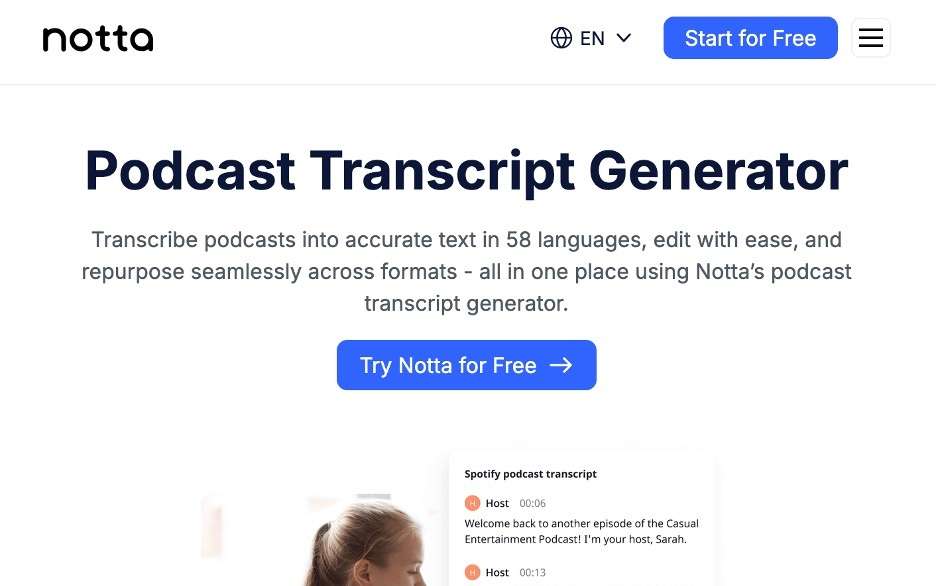
Restream
Restream offers free podcast transcription, requiring no account setup or downloads. The service supports 15 languages, including English, Spanish, and Mandarin, while maintaining strict security by deleting files after processing. Podcasters can upload various audio formats (MP3, WAV, MP4) and receive plain text transcripts for content repurposing.
Restream Studio integration provides a seamless recording-to-transcript workflow for podcast creators. The intuitive interface makes transcription accessible even for technical beginners.
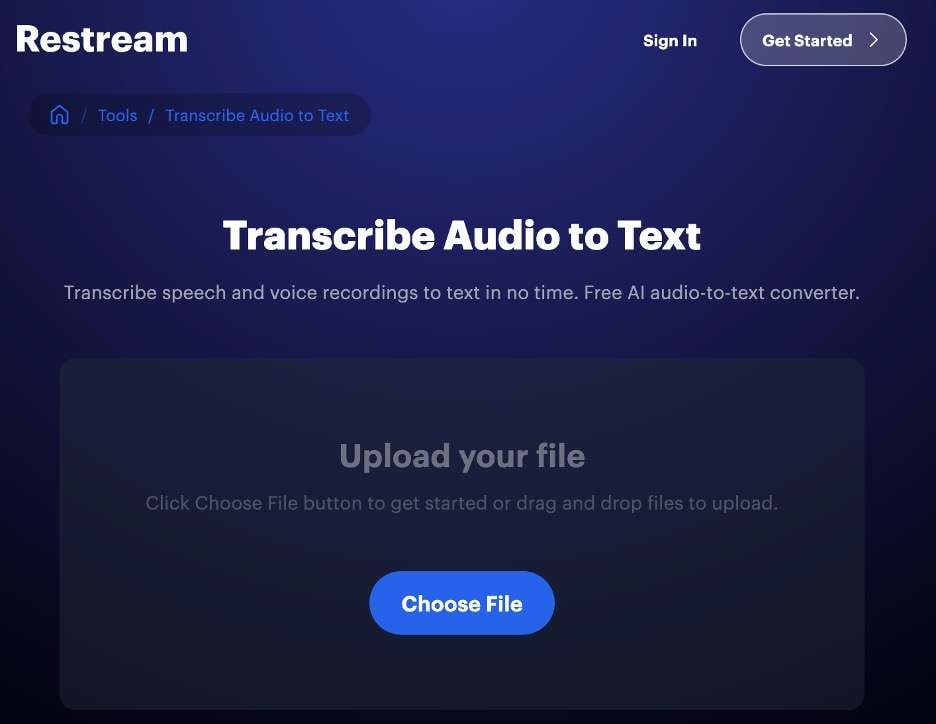
Podsqueeze
Podsqueeze delivers high-speed podcast transcription, processing 30-minute episodes in under 5 minutes. The platform automatically detects and labels different speakers with timestamps throughout transcripts. Podcasters receive ready-to-publish show notes, episode summaries, and content highlights generated directly from audio.
Podsqueeze creates SRT caption files for video podcasts on YouTube and other social media platforms. The service improves podcast SEO by generating keyword-rich transcripts for episode pages.

Kapwing
Kapwing combines podcast transcription with comprehensive editing capabilities for audio and video content. The platform accurately converts spoken podcast content to text, allowing direct transcript editing with automatic audio synchronization.
Podcasters can download transcripts as TXT files or use the platform's translation features to reach international audiences in over 70 languages. Kapwing's AI voice cloning technology enables custom voiceovers for repurposed podcast content without additional recording sessions.
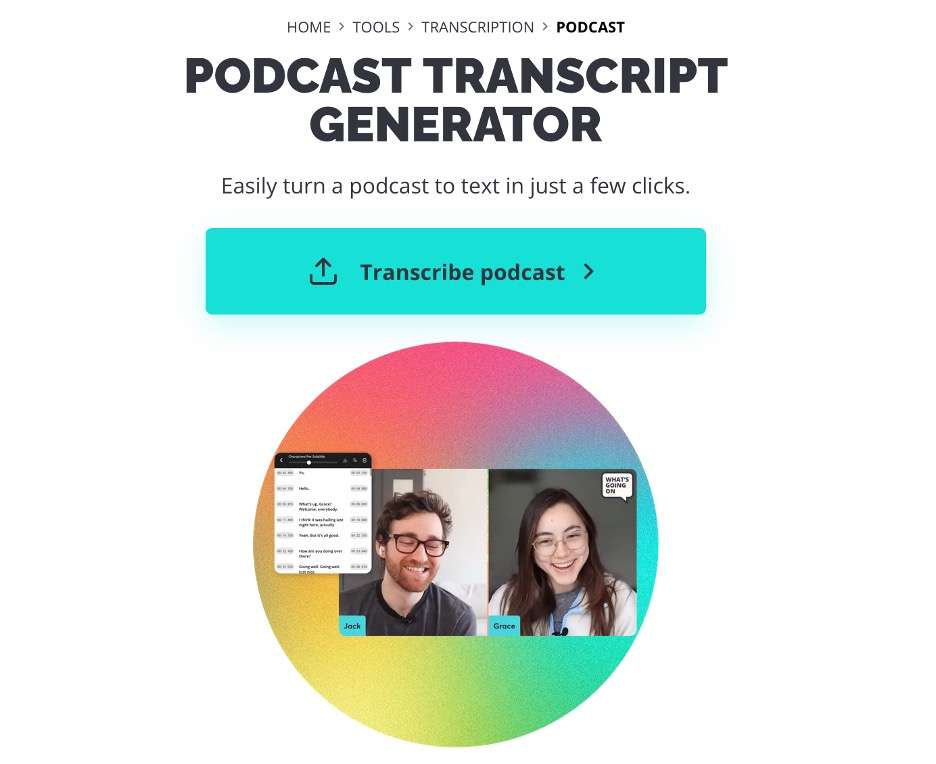
Descript
Descript provides 95% accurate podcast transcription within a complete audio editing environment. The platform's unique text-based editing allows podcasters to modify audio by editing the transcript text. Automatic speaker detection and labeling improve transcript organization for multi-person podcast episodes.
Podcasters can export in various formats, including SRT, Word, and Markdown. Advanced AI features remove filler words and speech disfluencies while maintaining a natural conversation flow.
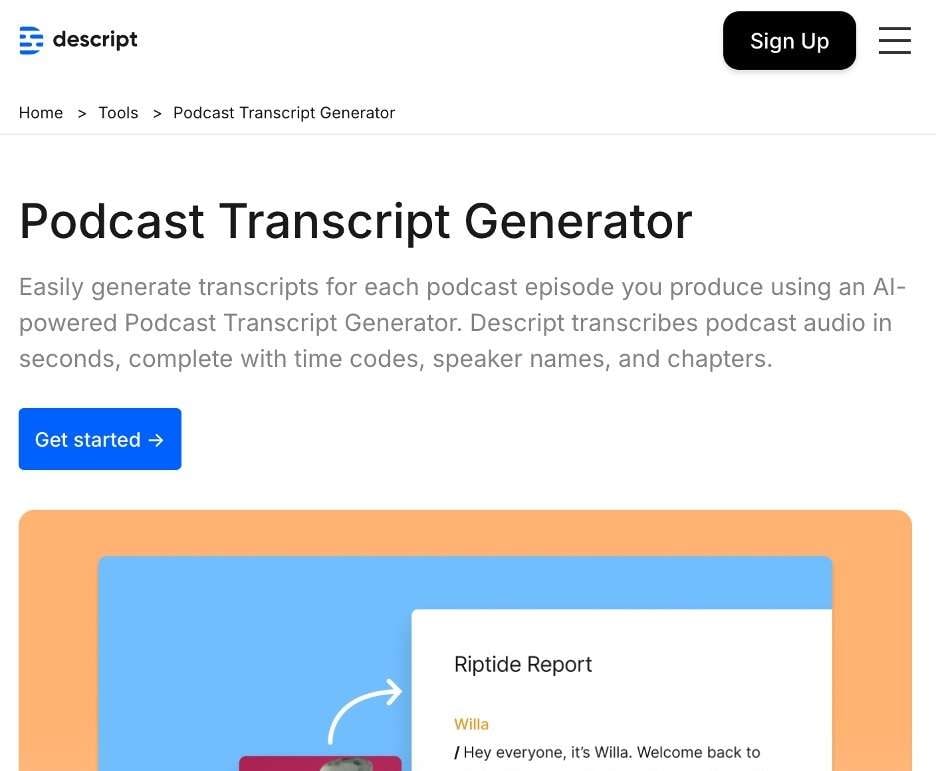
Tactiq
Tactiq captures live podcast recordings through a Chrome extension that works directly with video conferencing platforms. The tool integrates with Google Meet, Zoom, and Microsoft Teams for real-time transcription during remote podcast interviews.
Multi-speaker identification creates properly labeled transcripts for podcast episodes with multiple participants. Completed transcripts can be exported to Google Docs, Notion, Slack, or PDF formats. The extension supports over 30 languages with automatic detection capabilities for international podcast guests.
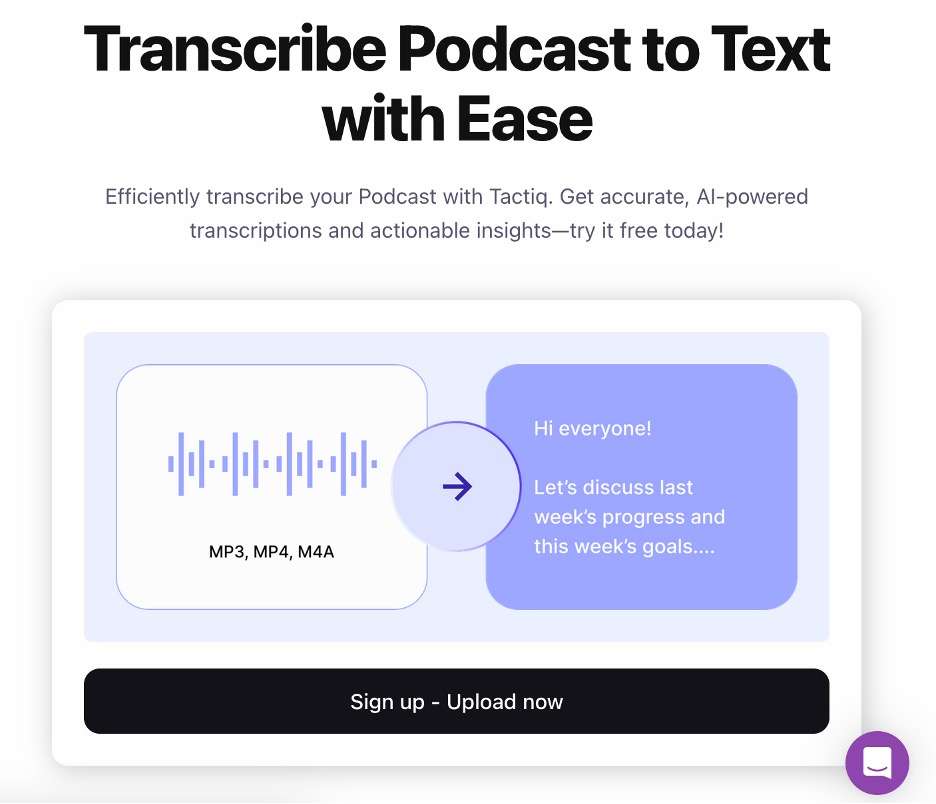
Part 2: How To Make the Most out of Podcast-to-Text Files
Now that you know which free podcast-to-text converters to use, here are some tips you can follow to maximize the most out of the generated output of the said tools.
Content Repurposing (Blog Articles)
Transform podcast episodes into complete blog posts by organizing transcripts into structured articles. Remove filler words, verbal pauses, and tangential conversations while preserving key insights. Add relevant headers, subheadings, and formatting to improve readability.
Include links to resources mentioned during episodes for additional value. Incorporate SEO keywords naturally within the text to improve search visibility. Publish these articles on your podcast website to capture search traffic from topics discussed during episodes.
Social Media Content
Extract compelling quotes and insights from transcripts for social media posts. Create quote graphics using short, impactful statements from guests or hosts. Develop carousel posts highlighting main points from episodes in digestible segments.
Schedule regular posting of transcript excerpts to maintain consistent social presence between episode releases. Use transcript analysis to identify highly engaging topics for dedicated social content series. Tag guests mentioned in transcript excerpts to extend content reach to their audiences.
Highlight Short Clips With Text Content
Identify powerful moments in transcripts to create audiogram clips with synchronized captions. Select transcript sections containing surprising statistics, emotional stories, or practical advice. Create short-form vertical videos with text overlay for platforms like TikTok and Instagram Reels.
Develop “best of” compilation videos using transcript timestamps to locate top moments across multiple episodes. Generate teaser clips with captivating transcript segments to promote upcoming episodes.
Analyzing Data for Podcasting Online
Use transcript analysis to understand listener engagement patterns and topic performance. Identify frequently discussed keywords and phrases to inform episode planning and SEO strategy. Compare engagement metrics against transcript content to determine which topics resonate most with audiences. Analyze question patterns from interview transcripts to improve future guest preparation.
Conclusion
As you’ve gone through seven podcast audio-to-text converters, it’s time to decide by thoroughly trying out each tool. Remember, using a tool that supports AI in the transcription is a massive plus because AI makes the transcription more accurate. After all, AI can understand human nuance much better than regular transcription services.
If you’re looking for a tool to make short-form videos from your podcasts with compelling captions, use Wondershare Filmora. It’s a great tool that you can bring anywhere and everywhere to create, produce, and engage with your audience.



 100% Security Verified | No Subscription Required | No Malware
100% Security Verified | No Subscription Required | No Malware


